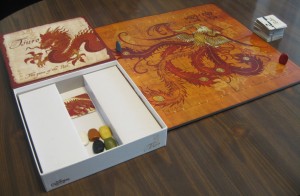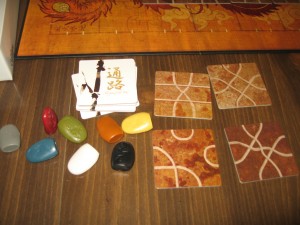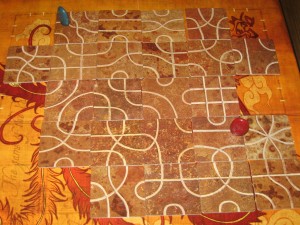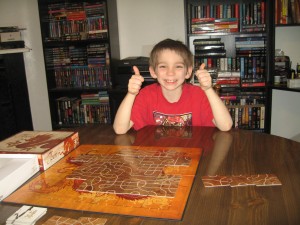Sometimes the best things come in the smallest packages and sometimes, the smallest package does not always imply simplicity. I’ve often stated in my reviews that the hallmark of a great game is one that is simple to learn and difficult to master…this game certainly applies.
In Tsuro, “The Game of the Path”, players will be laying tiles and moving their dragon along the path you set for them. Let’s take a quick look at what comes in the game and how it is played before going into the review.
Components
Stone Markers – There are a total of eight stone markers, each of a different color, that represent the dragons that players will be moving around the board.
Tiles – The thirty-five tile “cards” serve as the way a player’s dragon piece moves along the board. A total of three tiles make up a player’s hand.
Dragon Tile – There’s only one dragon tile and it serves as an indicator on who gets to draw new tiles should the main draw pile run out. The player with the dragon tile gets to draw tiles from the players who are eliminated first. A player gets the dragon tile when they attempt to draw from the main draw pile and can’t because there are none left.
Game Board – The board’s layout is very simple. There are empty squares where the tiles go and marks at the edge of the board that serve as possible starting locations for each player’s dragon.
Setup & Gameplay Mechanics
Players receive one dragon of their choice and place it on one of the starting locations at the edge of the board, non-adjacent to someone else’s. They also receive three tiles to form their hand. The oldest player goes first.
Turns are very simple. The current player picks from one of the three tiles in their hand, rotates it how they want, and places it on a space adjacent to their dragon. The player then moves their dragon along the path as indicated on the tile until it either reaches an empty space (in which case it stops and the turn ends) or until it reaches the end of the board (in which case the player is eliminated from the game).
After a player plays a tile and moves their dragon, they draw a new tile. Play continues until only one dragon remains on the board. If two dragons end up colliding with each other, they are both eliminated from the game.
The Dragon Tile & Variants
The manual doesn’t do a very good job in explaining how the dragon tile works. There are multiple theories and interpretations all over the web and I think that it’s more complicated than it needs to be. Luckily, the draw pile won’t run out very often and the chances of that happening decrease as fewer players play. I’ll do my best to explain my interpretation below…it may or may not be “correct”, but it worked for us.
In the event that the game has gone on for a while and players haven’t been eliminated, the draw pile may run out. The first person who goes to draw from the pile and can’t receives the dragon tile…this serves to keep track of who gets first priority for drawing new tiles when players are eliminated.
When a player is eliminated, they place their hand back into the draw pile. If the draw pile is still stocked, then everyone’s hands are full and all is well. If the draw pile is empty, this means that players may not have a full hand and that someone may have the dragon tile. In this event, the player with the dragon tile receives a tile and players continue clockwise around the board taking one tile from the draw pile until either all players have a full hand or the draw pile runs out. If the latter happens, the last player to try to take a tile gets the dragon tile.
I know, it sounds complicated. The best advice I can give you is not to worry about following the rules to the letter and to make up and use what works. After all, you’re playing a game, not building a nuclear reactor.
Below is a variant I came up with that may make better use of the dragon tile during games with fewer players.
Two to Four Player Variant: Include the dragon tile randomly into the deck. When a player picks it up from the draw pile, they can place it ANYWHERE on the board but must be at least two spaces away from any player. Anyone unlucky enough to end up on the dragon tile is eliminated.
The Review
Overall, the game is a lot of fun. It serves as a quick fix for family fun night for when we don’t have a lot of time to play. Gameplay is simple and I tought it to my eleven year old in under a minute.
Placing a tile sounds like it wouldn’t involve that much strategy, but being able to rotate the tile before placement coupled with the paths already existing on the board forces players to think ahead lest they find themselves in an unfavorable position. It’s very easy to get caught up in, “well, placing this tile this way will bring me here…this tile this way here…then ultimately here and here…etc etc etc.”
I highly recommend this game to players of all ages. It would do well as a filler in between longer sessions or for nights where families aren’t able to commit to longer games.
Final Verdict: 8/10




